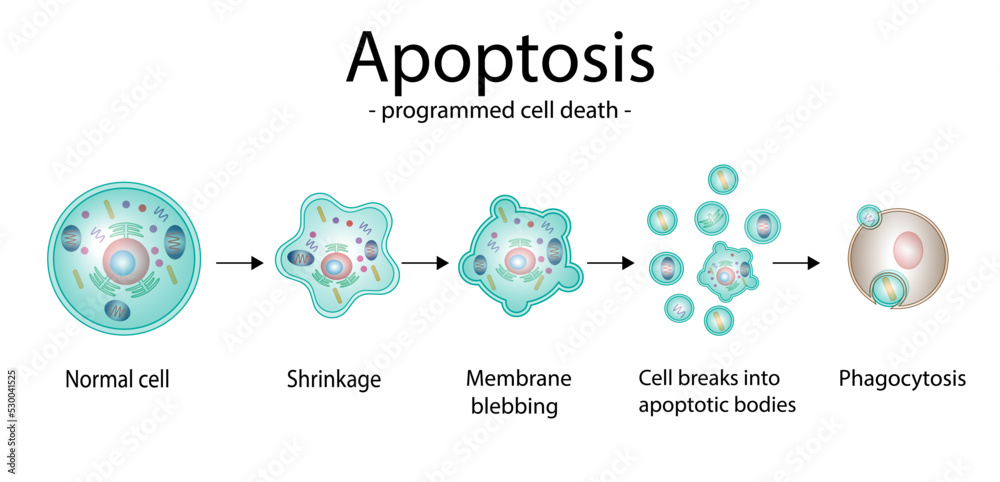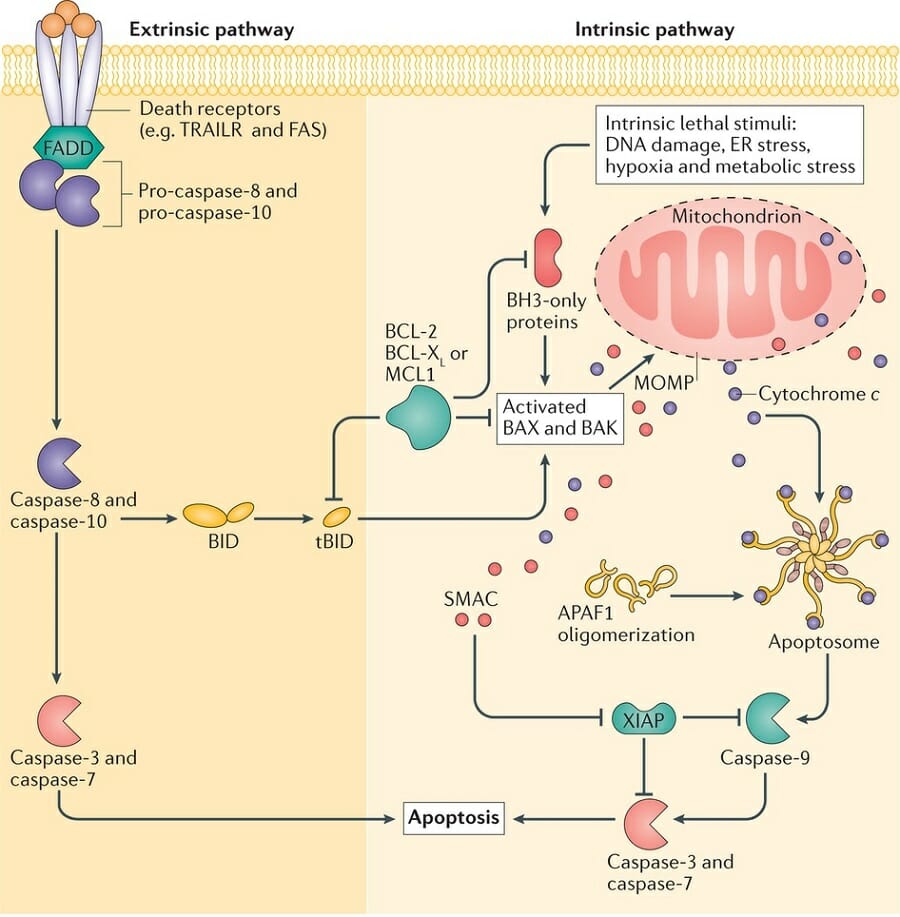Makindo Medical Notes"One small step for man, one large step for Makindo" |
|
|---|---|
| Download all this content in the Apps now Android App and Apple iPhone/Pad App | |
| MEDICAL DISCLAIMER: The contents are under continuing development and improvements and despite all efforts may contain errors of omission or fact. This is not to be used for the assessment, diagnosis, or management of patients. It should not be regarded as medical advice by healthcare workers or laypeople. It is for educational purposes only. Please adhere to your local protocols. Use the BNF for drug information. If you are unwell please seek urgent healthcare advice. If you do not accept this then please do not use the website. Makindo Ltd. |
Apoptosis
-
| About | Anaesthetics and Critical Care | Anatomy | Biochemistry | Cardiology | Clinical Cases | CompSci | Crib | Dermatology | Differentials | Drugs | ENT | Electrocardiogram | Embryology | Emergency Medicine | Endocrinology | Ethics | Foundation Doctors | Gastroenterology | General Information | General Practice | Genetics | Geriatric Medicine | Guidelines | Haematology | Hepatology | Immunology | Infectious Diseases | Infographic | Investigations | Lists | Microbiology | Miscellaneous | Nephrology | Neuroanatomy | Neurology | Nutrition | OSCE | Obstetrics Gynaecology | Oncology | Ophthalmology | Oral Medicine and Dentistry | Paediatrics | Palliative | Pathology | Pharmacology | Physiology | Procedures | Psychiatry | Radiology | Respiratory | Resuscitation | Rheumatology | Statistics and Research | Stroke | Surgery | Toxicology | Trauma and Orthopaedics | Twitter | Urology
Related Subjects: |Apoptosis |Cancer Pathology
Apoptosis is a form of programmed cell death that occurs in multicellular organisms. It is a highly regulated process that allows the body to eliminate damaged, unwanted, or potentially harmful cells in a controlled manner, preventing inflammation and damage to surrounding tissues.
Mechanisms of Apoptosis

Pathways
- Intrinsic Pathway (Mitochondrial Pathway) :
- Triggered by internal signals such as DNA damage, oxidative stress, or lack of growth factors.
- Involves the release of cytochrome c from mitochondria into the cytosol.
- Cytochrome c binds to Apaf-1, forming the apoptosome, which activates caspase-9.
- Caspase-9 activates downstream effector caspases (e.g., caspase-3), leading to cell death.
- Extrinsic Pathway (Death Receptor Pathway) :
- Triggered by external signals binding to death receptors on the cell surface (e.g., Fas, TNF receptor).
- Receptor-ligand binding recruits adaptor proteins and forms the death-inducing signaling complex (DISC).
- DISC activates caspase-8, which in turn activates effector caspases (e.g., caspase-3).
- May also cross-talk with the intrinsic pathway through the cleavage of Bid, a pro-apoptotic Bcl-2 family member.

Molecular Players in Apoptosis
- Caspases :
- Proteolytic enzymes that play essential roles in apoptosis.
- Initiator caspases (e.g., caspase-8, caspase-9) activate effector caspases (e.g., caspase-3, caspase-7).
- Effector caspases cleave various cellular substrates, leading to the morphological and biochemical changes characteristic of apoptosis.
- Bcl-2 Family Proteins :
- Regulate the intrinsic pathway of apoptosis by controlling mitochondrial outer membrane permeabilization (MOMP).
- Anti-apoptotic members (e.g., Bcl-2, Bcl-xL) inhibit apoptosis by preventing MOMP.
- Pro-apoptotic members (e.g., Bax, Bak) promote MOMP and cytochrome c release.
- BH3-only proteins (e.g., Bid, Bim, PUMA) activate pro-apoptotic members or inhibit anti-apoptotic members.
- Death Receptors :
- Members of the TNF receptor superfamily (e.g., Fas, TNF receptor) involved in the extrinsic pathway.
- Upon ligand binding, death receptors recruit adaptor proteins (e.g., FADD) to form the DISC, initiating the caspase cascade.
- Apaf-1 (Apoptotic Protease-Activating Factor-1) :
- Central component of the apoptosome in the intrinsic pathway.
- Forms a complex with cytochrome c and procaspase-9, leading to caspase-9 activation.
Morphological and Biochemical Features of Apoptosis
- Cell Shrinkage :
- Reduction in cell volume due to the loss of cytoplasmic and nuclear components.
- Chromatin Condensation :
- Condensation and fragmentation of chromatin into dense, compact structures.
- Formation of Apoptotic Bodies :
- Fragmentation of the cell into membrane-bound apoptotic bodies containing organelles and nuclear material.
- Phosphatidylserine Exposure :
- Translocation of phosphatidylserine from the inner to the outer leaflet of the plasma membrane, serving as an "eat-me" signal for phagocytes.
- DNA Fragmentation :
- Cleavage of genomic DNA into oligonucleosomal fragments, detectable by DNA laddering or TUNEL assay.
Physiological and Pathological Roles of Apoptosis
- Development and Tissue Homeostasis :
- Elimination of unnecessary or damaged cells during development and maintaining tissue integrity.
- Immune System Regulation :
- Removal of autoreactive T and B cells to prevent autoimmunity.
- Elimination of infected or transformed cells by cytotoxic T lymphocytes and natural killer cells.
- Pathological Conditions :
- Neurodegenerative Diseases : Excessive apoptosis contributes to the loss of neurons in conditions like Alzheimer's, Parkinson's, and Huntington's diseases.
- Cancer : Evasion of apoptosis allows cancer cells to survive and proliferate uncontrollably.
- Autoimmune Diseases : Defective apoptosis can lead to the survival of autoreactive immune cells, causing autoimmunity.
- Ischaemic Injury : Apoptosis contributes to cell death in tissues affected by inadequate blood supply, such as in heart attacks and strokes.
Detection and Analysis of Apoptosis
- Microscopy :
- Observation of morphological changes using light, fluorescence, or electron microscopy.
- Flow Cytometry :
- Measurement of cell size, granularity, and Annexin V/propidium iodide staining to detect apoptotic cells.
- TUNEL Assay :
- Detection of DNA fragmentation by labeling the ends of fragmented DNA with modified nucleotides.
- Western Blotting :
- Analysis of apoptosis-related proteins, such as cleaved caspases and PARP.
- ELISA :
- Quantification of soluble apoptotic markers, such as cytoplasmic histone-associated DNA fragments.
Summary
Apoptosis is a vital process of programmed cell death that maintains tissue homeostasis and eliminates damaged or potentially harmful cells. It occurs through intrinsic and extrinsic pathways involving key molecular players such as caspases, Bcl-2 family proteins, and death receptors. Apoptosis is characterized by distinct morphological and biochemical changes and plays crucial roles in development, immune regulation, and various pathological conditions. Understanding apoptosis is essential for developing therapeutic strategies to modulate cell death in diseases such as cancer, neurodegenerative disorders, and autoimmune diseases.